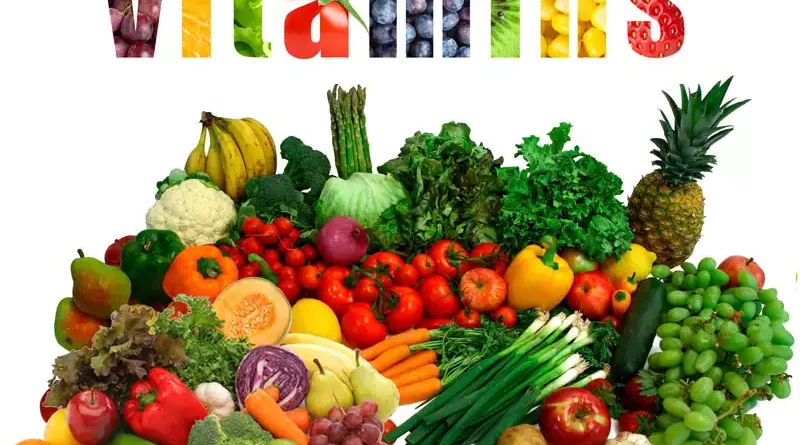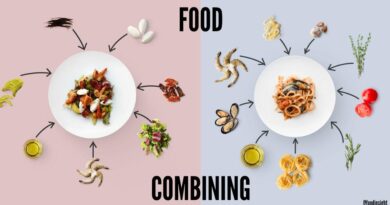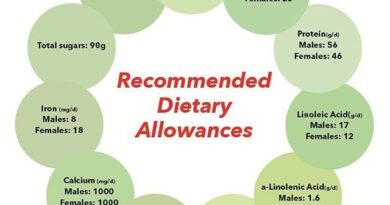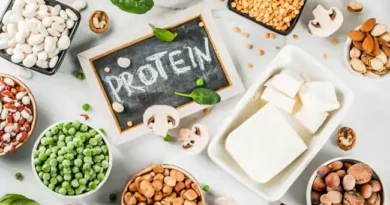Vitamins
What are Vitamins ?
We all have heard that Vitamins are very important for our body. But, what are vitamins exactly ? ‘Vita’ means “Life” and so, Vitamins means anything that is vital and essential for life and health. They regulate metabolism, help in the growth and maintenance of our body and protect against disease. Vitamins are organic compounds (contains Carbon) and present in minute quantities in food.
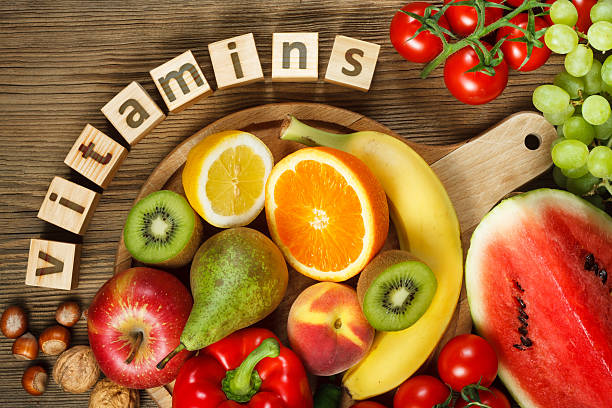
What are different types of Vitamins ?
Depending upon their characteristics, the vitamins can be broadly classified into two categories :-
- Water-soluble Vitamins. B1 (Thiamine), B2 (Riboflavin), B3(Niacin), B9 (Folic Acid), B12 (Cobalamine) and Vitamin C
- Fat-soluble Vitamins. Vitamin A,D,E and K.
What are Water Soluble Vitamins ?
Water-soluble vitamins are those that are dissolved in water and readily absorbed into tissues for immediate use. Because they are not stored in the body, they need to be replenished regularly in our diet. Any excess of water-soluble vitamins is quickly excreted in urine and will rarely accumulate to toxic levels.
What are Various types of Water Soluble Vitamins ?
The water-soluble vitamins include the B-complex group and vitamin C, each of which offers the following health benefits:
- Vitamin B1 (thiamine) helps to release energy from foods and is important in maintaining nervous system function.
- Vitamin B2 (riboflavin) helps promotes good vision and healthy skin and is also important in converting the amino acid tryptophan into niacin.
- Vitamin B3 (niacin) aids in digestion, metabolism, and normal enzyme function as well as promoting healthy skin and nerves.
- Vitamin B5 (pantothenic acid) aids in metabolism and the formation of hormones.
- Vitamin B6 (pyridoxine) aids in protein metabolism and the production of red blood cell, insulin, and hemoglobin.
- Vitamin B7 (biotin) helps release energy from carbohydrates and aids in the metabolism of fats, proteins, and carbohydrates from food.
- Vitamin B9 (folate or folic acid) also aids in protein metabolism and red blood cell formation and may reduce the risk of neural tube birth defects.
- Vitamin B12 (cobalamin) aids in the production of normal red blood cells as well as the maintenance of the nervous system.
- Vitamin C (ascorbic acid) is central to iron absorption and collagen synthesis. It aids in wound healing and bone formation while improving overall immune function.1
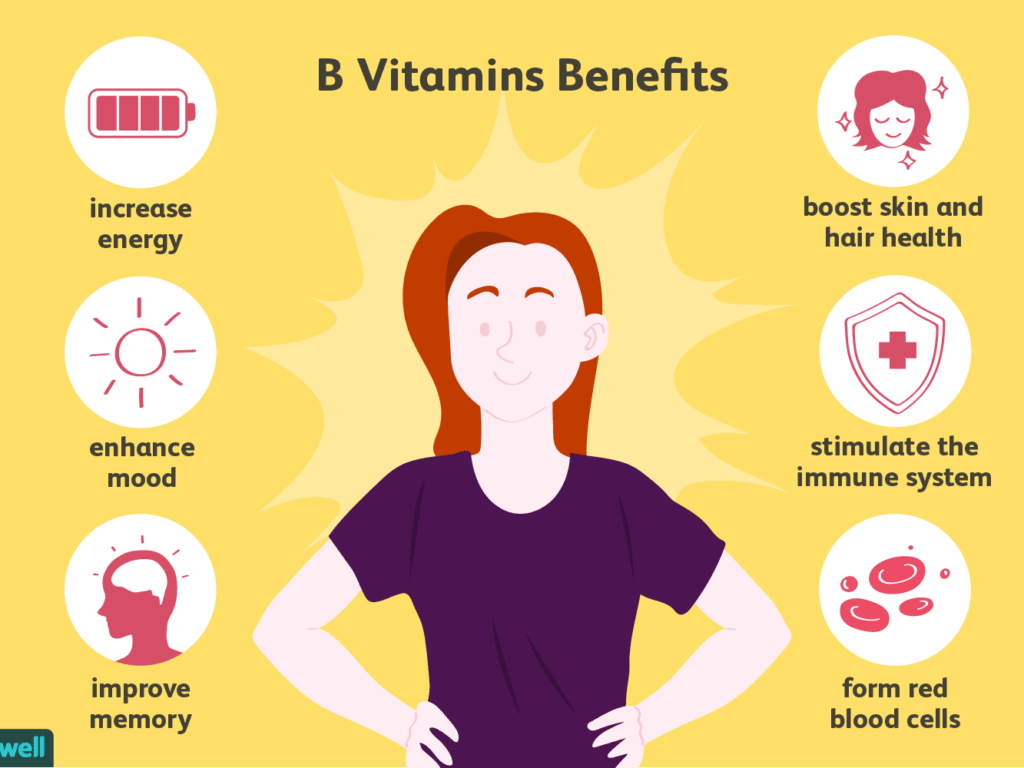
Vitamins of B-Complex Group Explained
They usually occur together in the food. B vitamins act as coenzymes and help in the metabolism of carbohydrates, proteins and fats. Coenzymes are substances which are needed by enzymes to do their job effectively. Each of the B-Complex vitamins is explained below :-
- Thiamine (B1). These are widely distributed in animal and plant foods. Almost all the foodstuff except fats, oils and sugars contain small amount of thiamine. Among plant foods such as whole grain cereals (i.e wheat and rice) and whole pulses are rich sources of thiamine. In animal foods, lean meats, poultry and egg yolk are good sources. After ingestion, thiamine is absorbed and enters the bloodstream. It is utilised to perform several functions. Excess thiamine is excreted in the urine. Thiamine plays important role in the metabolism of carbohydrates (by becoming coenzymes) i.e burning or oxidation of glucose to produce energy.
- Riboflavin (B2). Milk, liver, kidney, eggs and green leafy vegetables are good sources of riboflavin. Whole grain cereals and pulses contain fair amounts. B2 is absorbed from upper part of the small intestine into the bloodstream and is taken to various body tissues to perform specific functions and excess B2 is excreted in the urine. Riboflavin plays an important role in the metabolism of carbohydrates, fats and proteins. Because it forms part of two distinct coenzymes which help to release energy from the end products of digestion of carbohydrated, fats and proteins.
- Niacin (B3). Meat,fish,poultry,cereals,pulses,nuts and oilseeds are good sources. I can also be formed in the body from an amino acid called tryptophan. The tryptophan present in milk protein can be converted to niacin in the body. Thus milk provides appreciable amounts of niacin. Niacin is also part of coenzymes which help to release energy from the end products of the digestion of carbohydrates, fats and proteins. It thus helps in their metabolism.
- Folic acid (B9). Widely distributed in foods. Green leafy vegetables and organ meats (like liver and kidney) are rich sources of folic acid. Whole grain cereals, pulses, eggs and dairy products are also good source. After absorption folic acid is taken to various body tissues through the blood stream for specific functions. Some amount of folic acid is stored in the body mainly in the liver. Body stores sufficient folic acid to meet requirements for several months. Folic acid plays important role in blood formation (Red blood cells)
- Cobalamin (B12). Only present in the foods of animal origin. Liver, kidney, milk, eggs and sea foods are rich sources of B12. It is also synthesised in our body in the intestinal tract by certain helpful bacteria. It can only be absorbed in the presence of a specific chemical substance called intrinsic factor which is secreted by the cells of the stomach. Ingested B12 combines with intrinsic factor and is absorbed from the small intestine. Our body requirement for vitamin B12 is very small. Consumption of even small amounts of animal foods like milk can take care of B12 needs of the body. B12 is necessary for the proper functioning of the digestive tract, nervous system and the bone marrow. In the bone marrow, B12 is also involved in the formation of normal RBCs like folic acid.
What is Vitamin C ?
Vitamin C or ascorbic acid is also termed as the “fresh food vitamin” because fresh citrus fruits (like orange, lime and lemon) and other fruits and vegetables like guava, amla, papaya, green leafy vegetables, tomatoes, green chillies and capsicum are some of the excellent sources of vitamin C.
Other sources :-
- Root vegetables like potato and sweet potato contain small amounts.
- Cereals and pulses are poor in Vitamin C but when sprouted and fermented become good sources.
- Animal foods like fish, meat, milk, egg etc. Contain little or no Vitamin C.
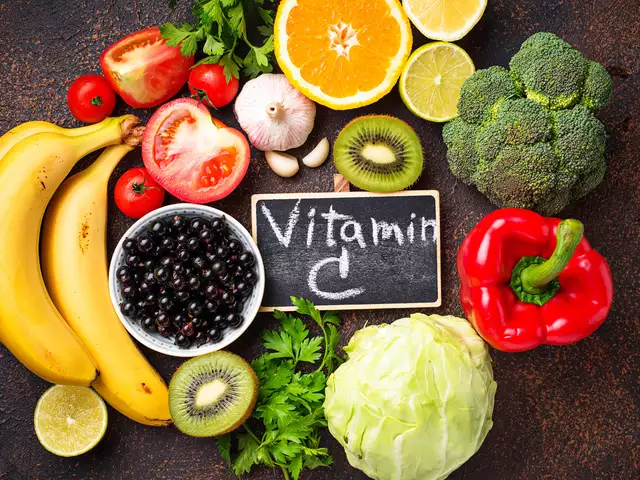
Absorption and Utiisation :- Vitamin C is absorbed from the digestive tract and then distributed to various body tissues. Organs and glands like the spleen, bone marrow, liver, pancreas, kidney and the retina of the eye have a high concentration of ascorbic acid.
Why Vitamin C is useful to us ?
- Wound healing :- It helps in formation of special kind of protein called collagen. The formation of collagens at the site of wound or injury aids in its healing. Deficiency of Vitamin C in the diet may result in fragile blood vessels which can easily rupture.
- Dealing with stress :- Vitamin C plays important role in the release of two hormones – Epinephrine and norepinephrine from the adernal glands of the body. These hormones help the body to deal with stressful situations like day-to-day tensions, stresses of infections and injury.
- Absorption of Iron :- Iron is an essential component of RBCs. Vitamin C aids absorption of iron by converting it into a more suitable form for absorption.
- Protecting certain substances from destruction :- Like vitamin E, vitamin C protects certain substances e.g. Vitamin A and unsaturated fatty acids from being destroyed.
What are Fat soluble Vitamins ?
Fat-soluble vitamins are dissolved in fats. They are absorbed by fat globules that travel through the small intestines and distributed through the body in the bloodstream. Unlike water-soluble vitamins, excess fat-soluble vitamins are stored in the liver and fatty (adipose) tissues for future use They are found most abundantly in high-fat foods and are better absorbed if eaten with fat.
What are Various types of Fat Soluble Vitamins ?
There are four types of fat-soluble vitamin, each of which offers different benefits:
- Vitamin A is integral to bone formation, tooth formation, and vision. It contributes to immune and cellular function while keeping the intestines working properly.
- Vitamin D aids in the development of teeth and bone by encouraging the absorption and metabolism of phosphorous and calcium.
- Vitamin E is an antioxidant that helps fight infection and keeps red blood cells healthy.
- Vitamin K is central to blood clotting and also keeps bones healthy.
What is Vitamin ‘A’ and what are its sources ?
Vitamin ‘A’ or retinol is found only in the foods of animal origin. Animal foods like milk, butter, ghee, egg, fish and liver are rich sources of vitamin A. Liver oils of fish like halibut, cod and shark are richest sources. Plant foods do not contain retinol. They contain certain orange or yellow coloured pigments called carotenoids which can be converted to retinol in the body.
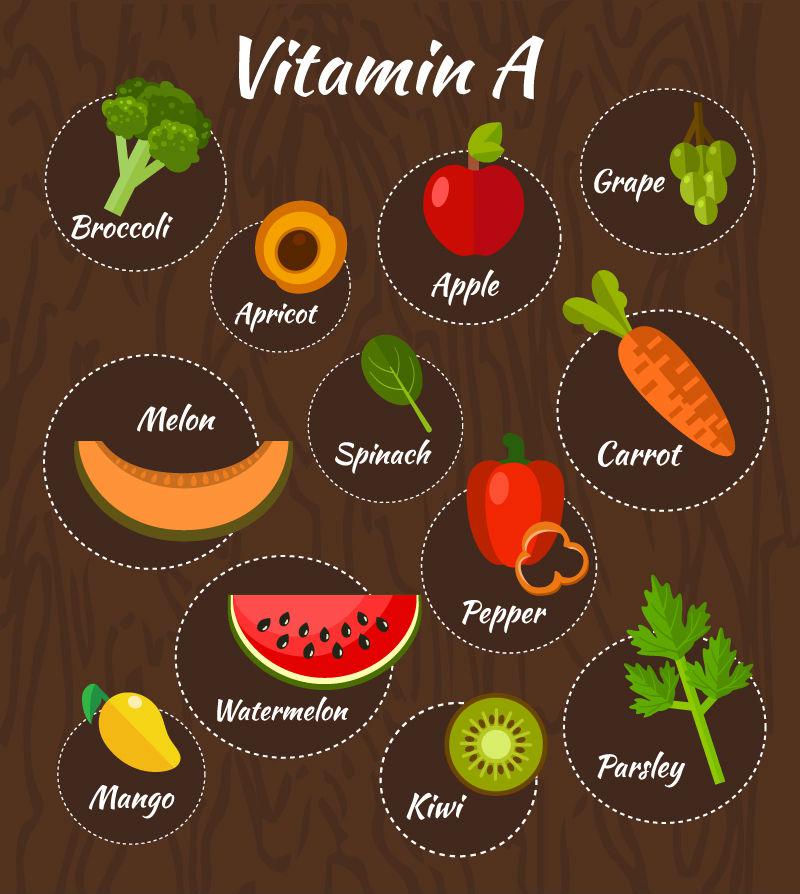
What is Beta Carotene and how it is related to Vitamin ‘A’ ?
Beta carotene is the most widely distributed carotenoid in plant foods. They can be converted to retinol by the body. Ripe fruits such as mango, papaya and yellow/orange vegetables like carrot and pumpkin are rich in beta carotene. Green leafy vegetables also contain carotenoid pigments. Here the yellow and the orange colour of the carotenoid pigments is masked due to the presence of another pigment called chlorophyll. Green leafy vegetables such as spinach, mustard leaves and fenugreek leaves are very rich sources of beta carotene. The conversion of beta carotene to vitamin A or retinol is not very efficient in the body. In fact only half of the beta carotene absorbed is converted to retinol.
How Vitamin ‘A’ is absorbed and stored in the body ?
Vitamin A is ingested either in the form of retinol or carotene. After absorption from the intestinal cells, retinol forms a complex with some fat containing particles called chylomicrons and is taken to the bloodstream. Carotene is absorbed in much the same way as retinol. After absorption most of the carotene is converted to retinol in the cells of the small intestine itself. Retinol is transported by the blood to the liver as part of the chylomicrons. Approximately, 90% of the total absorbed vitamin is stored in the liver and the remaining 10% is distributed in other organs and glands like the kidneys, lungs and adrenal glands.
How Vitamin A is useful to us ?
- Maintaining normal vision :- The retina has two kinds of cells rods and cones. While rods are sensitive to dim lights, the cones respond to bright light. The rods contain a pigment called rhodopsin which is formed by the combination of a specific form of vitamin A with a protein. It breaks down into its components when exposed to bright light. In the dark these components (Vitamin A and protein) again combine to regenerate rhodopsin. So, when we go from light to dark we can’t see for sometime then rhodopsin is regenerated once again in the dark.
- Supporting Growth :- Vitamin A is essential for the growth of skeleton and soft tissues. With deficiency of vitamin A, bones don’t grow to their full length.
- Protecting against disease :- Vitamin A keeps epithelial tissues moist and healthy without which dry skin and cracks will appear in the skin or inner walls of the digestive tract or lungs. This makes it easy for the greens to enter and cause diseases like diarrhoea, respiratory infections and eye infections.
What is Vitamin ‘D’ and what are its sources ?
It is also called the “sunshine vitamin” because it is manufactured from a substance present in our skin on exposure to sunlight. Foods from animal origin like eggs, liver and butter contains vitamin D in significant amounts. However, fish liver oils are richest sources. Plant foods doesn’t contain Vitamin D.
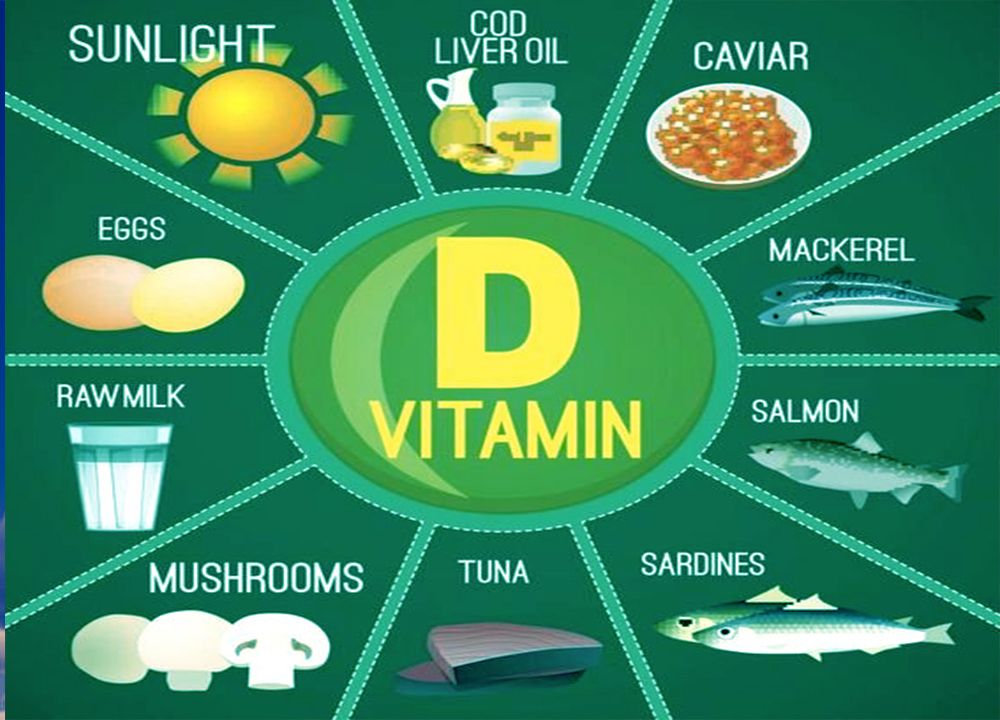
How Vitamin ‘D’ is absorbed and stored in the body ?
Vitamin D is absorbed along with fats from the small intestine. Bile is essential for effective absorption of fats and therefore of Vitamin D. After absorption, Vitamin D enters the bloodstream as a part of the chylomicrons. Vitamin D formed in the skin on exposure to sunlight also enters bloodstream. Both of which then taken to the liver where some of it is stored and remaining is distributed by blood to various body tissues.
How Vitamin ‘D’ is useful to us ?
Vitamin D makes bones strong and healthy. The process of deposition of minerals in the bone is termed as minearalisation of bones. Vitamin D aids the process of mineralisation in the following ways :-
- By increasing the absorption of calcium and phosphorus
- By helping in the deposition of calcium and phosphorus in bones
What is Vitamin ‘E’ ?
Present in almost all foodstuffs. Vegetable oils like groundnut, soya, cottonseed and sunflower are rich sources of Vitamin E. Other good sources are whole grain cereals, dark green leafy vegetables, pulses, nuts and oilseeds. Foods of animal origin are low in Vitamin E. However, egg yolk, butter and liver contains some amount of Vitamin E.
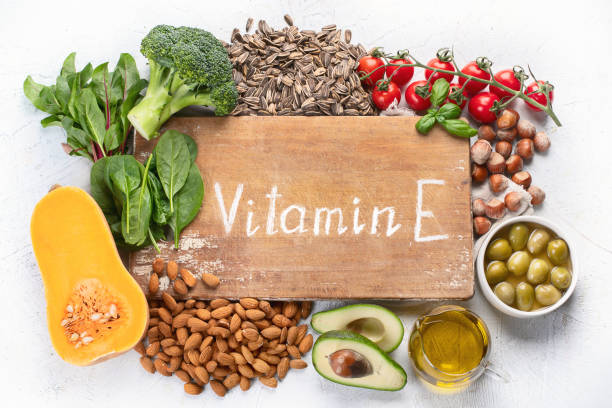
Absorption and Storage :- Like other fat soluble vitamins, absorption of Vitamin E also requires the presence of fat and bile. After absorption from the upper part of the small intestine, Vitamin E is carried to the liver through blood stream and is distributed to various body tissues.
Functions :- The main function is the protection it gives to other substances like unsaturated fatty acids, vitamin A and C. It prevents their destruction in the body as well as in foods.
What is Vitamin ‘K’ ?
Among plant foods, green leafy vegetables like spinach, cabbage and lettuce are rich sources of vitamin K. Animal foods such as egg yolk, milk and organ meats like liver are also good source. Approximately half of the Vitamin ‘K’ needed by us gets manufactured in the intestinal tract by bacteria and other half is obtained from animal and plant foods.
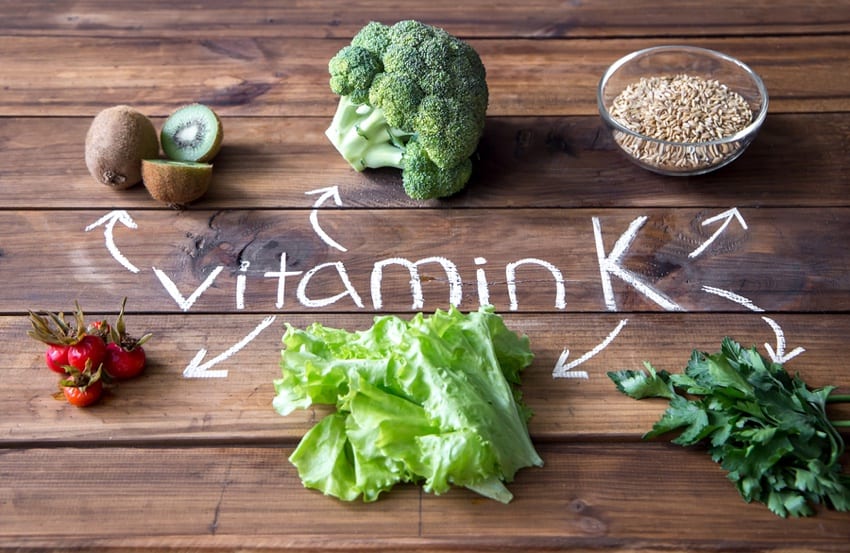
Absorption and Storage :- Absorption requires bile, so it takes place in upper part of small intestine and then distributed to various body tissues. Vitamin K is stored in very small amounts in the body.
Functions :- It plays important role in clotting of blood and is therefore termed as the “antibleeding vitamin”. It helps in formation of a protein called “prothrombin” which is essential for blood clotting.

